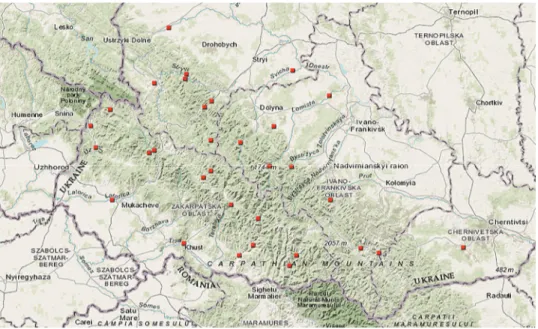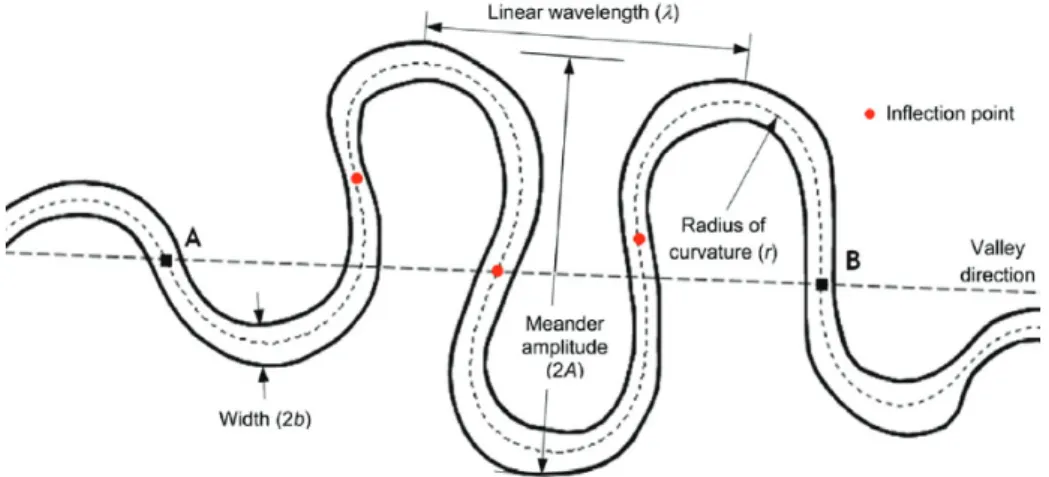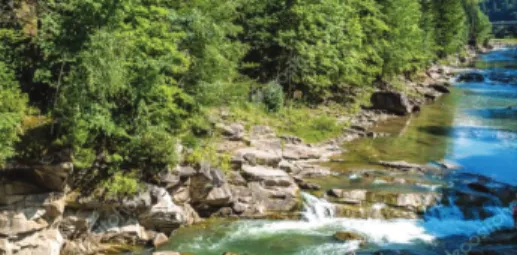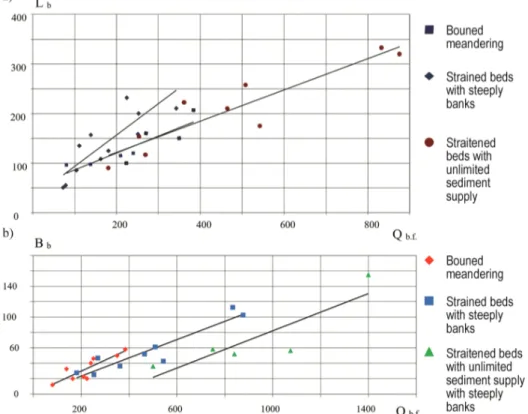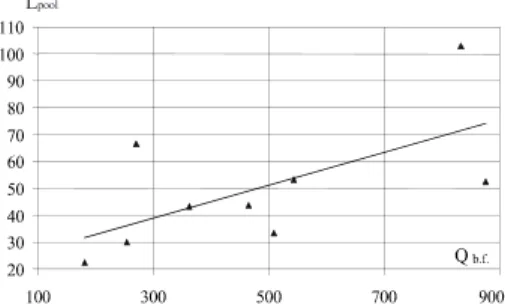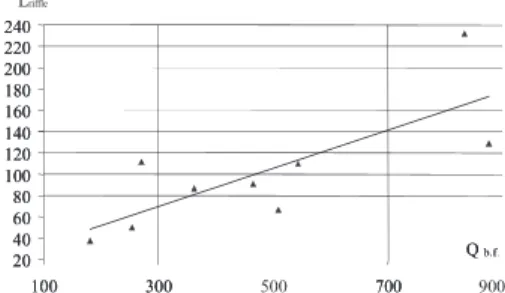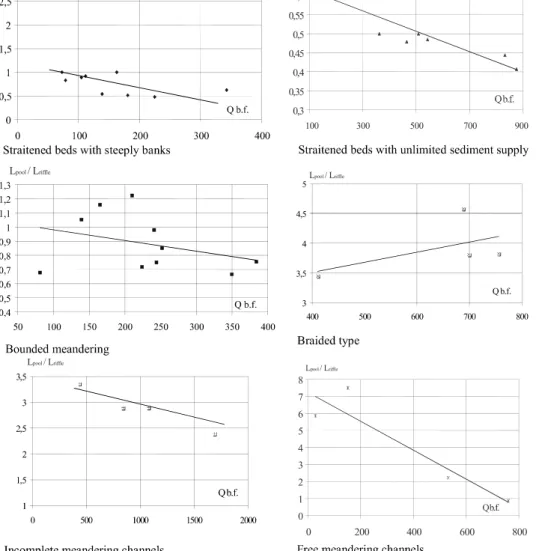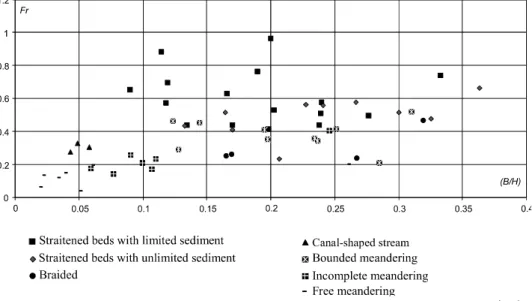SŁUPSKIE PRA CE GEOGRAFICZNE
Nr 15 ss. 183-194 2018 Przyjęto: Zaakceptowano: 18.01.2018 5.06.2018 ISSN 1641-8468© Instytut Geografii i Studiów Regionalnych Akademii Pomorskiej w Słupsku
Vasyl Korbutiak Mykhailo Korbutiak Ihor Hopchakh
National University of Water and Environmental Engineering Rivne, Ukraine
v.m.korbutiak@nuwm.edu.ua
Oleksandr Kaftan
TOV “Vodbud Ukraina” Kyiv,, Ukraine vodbud.ukr@ukr.net Ivan Kirvel Pomeranian University Słupsk kirviel@yandex.ru
HYDROMORPHOLOGICAL FEATURES
OF THE UKRAINIAN CARPATHIANS RIVERS
CECHY HYDROMORFOLOGICZNE RZEK
KARPAT UKRAIŃSKICH
Abstract: Riverbed processes on mount and submountig rivers are attributable to the part of bedload sediment in structure of sediment runoff. Our researches are directed to estab-lishing of calculation relationships useful for solving of engineering tasks such as calcu-lations of water and sediment discharges, riverbed deformation forecasting. In-situ data collected on rivers of Ukrainian Carpathians allows making some conclusions about flu-viomorphological features of river sediment structures forming and specificity of chan-nel deformations. It’s shown that relative values of riverbed form’s linear dimensions, which concerned with channel-forming water discharges, are obviously characterized transformations of bed-loads. Among others, they are displaying the influence of bound-ing factors on the bar’s formbound-ing for different types of riverbed process.
Hydraulic criterion, based on Froude number Fr and complex (В/Н) І, was verified for Carpathians Rivers and allows defining riverbeds by its types.
Key words: Carpathians Rivers, riverbed process, riverbed forms
Introduction
Our researches are dedicated to theoretical generalization and new methods of solving of scientific task of determination of calculation maximum rainfall water dis-charge values under missing or insufficiency of hydrometric observational data for river of Ukrainian Carpathians. Designing, construction and maintenance of flood-control and coast-protecting structures, heavy using of the Ukrainian Carpathians wa-ter resources and its preservation require corresponding scientific support. The neces-sity of further inquiry of distinguished problems is caused by variety of natural factors, that determine structural and dynamic peculiarities of mountain rivers (Lord, Ger-manoski, Allmendinger 2009).
A structural sediment formations (micro-, meso-, macroforms) of a mountain and submountain river segments are similar to lowland river in their evolution (Popov 1969, Rowiński, Radecki-Pawlik 2015). The basic distinctions between them lies in different ways of sediment supply, natural occurrence of primary rocks appearances, which causes bounding of riverbeds deformations, steep grades and in relatively fast-in-time riverbed deformations.
Methods of the research
The data of measurements of river mesoform parameters on 43 river sections (fig. 1) with different types of riverbed process are used in this work (Popov 1969; Buhin 1974)
Fig. 1. The research area location
Ryc. 1. Lokalizacja odcinków badawczych
Also, data on 139 measurements of bars and 168 measurements of riffles (or shallow reaches with fast flowing water) and pools (or deep reaches) (Leopold, Gor-don Wolman 1957) are generalized. The results of granulometric analysis of riv-erbeds for 62 sections of water gauge station have been used. Planform characteris-tics of a meandering river (linear wavelength, meander amplitude, radius of curvature (fig. 2), (Güneralp, Marston 2012)) were obtained from large-scale maps.
Fig. 2. Planform characteristics of a meandering river Ryc. 2. Schemat koryta rzeki meandrującej
Source: Güneralp, Marston 2012, p. 721
Value of flow channel-forming discharge Qb.f. accepted as a quantity of
water-flow, which possesses sufficient energy for forming typical morphological structures in dynamic balance with bed-flow system. This state is described by equation
. 3 2 6 1 9 , 0 0 . .
8
,
0
0435
,
0
bal a wV
i
h
S
d
,where dw.a. – weighted average value of riverbed’s sediment diameter, S0 –
coeffi-cient of sediment’s nonuniformity, h – hydraulic mean depth corresponding to chan-nel-forming water discharge, i – average weighted slope expressed in dimensionless units, Vbal – average velocity of flow corresponding to dynamic balance of bed-flow
system.
The results of research
There are 8 basic types of riverbed processes on Carpathians Rivers (Buhin 1974) (fig. 3). Data processing of field surveys allowed us to receive a several rela-tions with parameters of large riverbed forms and values of bed-formation water dis-charges. They are present some interest for analysis of Carpathians rivers riverbed features.
Straitened beds with limited sediment supply
https://pl.depositphotos.com/104407772/stock-photo-mountain-river-prut-in-yaremche.html
Straitened beds with steeply banks
https://www.van canyon Canal-shaped stream https://kurs.if.ua/news/gromadskyy_ruh_vilnyy_ dnister_zaklykaie_gromady_daty_vidsich_budiv nytstvu_novyh_ges_na_ritsi_50299.html Braided type http://www.ine.eko.org.pl/index_areas.php?rek =512
Straitened beds with unlimited sediment supply
http://iloveukraine.com.ua/p/zFKAGF
Incomplete meandering channels
http://vikna.if.ua/news/category/if/2016/07/29/5 7926/view
Bounded meandering
https://mr-brut.livejournal.com/170469.html
Free meandering channels
https://www.ukraine richki
istori%D1%97/
Fig. 3. Basic types of riverbed processes on Carpathians Rivers Ryc. 3. Podstawowe typy procesów korytowych dla rzek Karpat
Straitened beds with steeply banks
https://www.van-tramp.com/wp/maligne-canyon-jasper-national-park/
Braided type
http://www.ine.eko.org.pl/index_areas.php?rek =512
Incomplete meandering channels
http://vikna.if.ua/news/category/if/2016/07/29/5 7926/view
Free meandering channels
https://www.ukraine-is.com/uk/nakrasivishi-
richki-ukra%D1%97ni-legendi-ta-istori%D1%97/
Fig. 3. Basic types of riverbed processes on Carpathians Rivers korytowych dla rzek Karpat
The graphs of relations of lengths and width of bars and values of channel-forming water discharges for different type of riverbed processes are shown on fig. 4 (Qb.f. –
channel-forming water discharges, м3/с; Lb, Bb – length and width of bars, м).
The rate of bar’s increase depends on channel-forming water discharge. It’s char-acterized by approximately equal exponent for all types of beds.
Fig. 4. The graphs of relations of lengths (a) and width (b) of bars and the values of channel-forming water discharge
Ryc. 4. Wykresy zależności między długością (a), szerokością (b) łach a natężeniem prze-pływu wody formującej koryto
Source: own measured data (during 1975-2016)
Straitened beds (gorges) with limited sediment supply slightly differ from others. Relative values of bar’s length and width, which concerned with channel-forming wa-ter discharges, obviously characwa-terize transformations of bed-loads (fig. 5). They are displaying influence of bounding factors on forming of bars for different types of riv-erbed process. For example, the characteristic feature of straitened beds with steeply banks is the significant lengthening of bars at increasing of channel-forming water dis-charge, that is much stronger than augmentation its width. Seemingly a bounding fac-tor has a dominating role, that not allowing bedload sediments which has a form of feebly marked shoal to grow own width dimension. Part of sediments are washed down. The rate of bar’s increase depends on channel-forming water discharge. It’s characterized by approximately equal exponent for all types of beds.
Fig. 5. The graphs of relative ratio of bar’s length to width with concerned channel-forming water discharges
Fig. 5. Wykresy zależności między względnym znaczeniem długości do szerokości odsypiska a przepływem wody formującej koryto
Source: own measured data (during 1975-2016)
Straitened beds (gorges) with limited sediment supply slightly differ from others. Relative values of bar length and width, which concerned with channel-forming wa-ter discharges, obviously characwa-terize transformations of bed-loads (fig. 5). They are displaying influence of bounding factors on forming of bars for different types of riverbed process.
For example, the characteristic feature of straitened beds with steeply banks is the significant lengthening of bars at increasing of channel-forming water discharge, that is much stronger than augmentation its width. Seemingly a bounding factor has a dom-inating role, that not allowing bedload sediments which has a form of feebly marked shoal to grow own width dimension. Part of sediments are washed down. For strait-ened beds (gorges) with unlimited sediment supply a bounding factor has a compara-tively minority role. Their points on fig. 5 are characterizes by ambiguous order. But there is a trend to decrease of value Lb / Bb at increasing of channel-forming water
defined character. Obviously, it relates with form of bounding factor's influence. As is well known bounded meandering beds on Carpathians Rivers alternate with strained riverbed types. This causes a backwater effect while flood's increasing which doesn't let bars lengthen.
Diagram for incomplete meandering channels is demonstrative in this regard. The ratio Lb / Bb remains the same with channel-forming water discharge increasing. This
shows more stable state of riverbeds forms that develop without boundaring factors. By the in-situ survey data we made graphs which characterize changes of pools and riffles dimensions relatively to value of channel-forming water discharge (fig. 6, 7).
Fig. 6. The graphs of relates of pool’s length with channel-forming water discharges Fig. 6. Wykresy zależności między długością plosa a przepływem wody formującego koryto
Source: own measured data (during 1975-2016)
300 250 200 150 100 50 400 350 300 250 200 150 100 50 0
Fig. 7. The graphs of relates of riffle’s length with channel-forming water discharges
Fig. 7. Wykresy zależności między długością przemiału a przepływem wody formującej koryto
Source: own measured data (during 1975-2016)
Presented graphs are showing lengthen of reach and rift with channel-forming water discharge increasing for all of riverbed types in general view excepting braid-ed types.
For braided channels exists a neat tendency of decreasing length of pools and rif-fles at channel-forming water discharge increasing. Obviously, flood division into separate channels causes developing of several pools and riffles, that are commen-surable to channel’s dimensions. Rise of pool-riffle part’s number causes decreasing of their length.
Same features of riverbed processes are exposed by relation’s graphs based on ra-tio Lpool/Lriffle and according channel-forming water discharges (fig. 8). For strained
and meandering beds tendency to riffle’s lengthening is observing at water discharge growth. This fact is explained by influence of bed-formation water flow. Riffle crest's sediment more intensively transport into pools
Fig. 8. The graphs of relates of pool’s length with channel-forming water discharges
Fig. 8. Wykresy zależności między względną długością plosa a przepływem wody formującej koryto
This tendency is an evidence of advance in riffle’s zone movement relative to pools. So, riverbed topography of idem types possesses more flat slit shape.
For braided beds observing inverse relate (with regard to previous case) – when channel-forming water discharge increases, relative length of reaches zone also ris-es. Changing of carrying capacity along river length influences on changing bar’s parameters. If average flood depth and width are increasing then slopes and veloci-ties are distinctly decreasing. Changing of carrying capacity after outlet from moun-tains is especially evident. River looses bedload sediment’s volume significantly that causes lengthening of the distance between rift zones.
For investigating condition of bar’s forming V. Katolikov and Z. Kopaliani (2001) made extended studies based on hydromorphological theory of riverbed pro-cess. The authors come to conclusion that the main cause of riverbed form’s arising is a long-wave oscillations of stream’s velocity module. Different types of bed forms are defining by kinematics structure of stream. The criteria which define kinematics structure of stream should be Froude number Fr and parameters complex (В/Н)І. We attempted to test idem criteria’s functionality to identify different types of riverbed process by graph of function (fig. 9).
Fig. 9. Criterial distribution of the riverbed process type’s based on the expression Fig. 9. Podział dla typów procesu korytowego według kryterium
Source: own measured data (during 1975-2016)
Using of suggested criteria for Carpathians Rivers allowed rather neatly define riverbeds by it types. Straitened beds characterized by values Fr>0,5 and (В/Н)І<0,4; for canalized beds Fr = 0,3-0,6 and (В/Н)І<0,1; for bounded meander-ing Fr = 0,3-0,5 and (В/Н)І=0,1-0,3; braided type Fr = 0,25-0,3 and (В/Н)І= 0,15-0,3; incomplete meandering channels Fr = 0,16 - 0,3 and (В/Н)І=0,06-0,13; free meandering channels Fr < 0,16 and (В/Н)І<0,06.
I H B f Fr I H B f Fr I H B f Fr
Intensity of meandering also relates with value of channel-forming water dis-charge. Parameters of riverbed macroforms such as linear wavelength , meander amplitude, S radius of curvature R, are in the dependence to value of channel-forming water discharge:
R=162,82 Qb.f. 0,16 ; Q b.f. 0,18 ; S=28,70 Q b.f. 0,28 Conclusions
Hydromorphological bed-movement theory distinguishes six basic types of riv-erbed processes. All of them, with the exception of flood-plains multiple-pass type, are present in the Carpathian region. Among of them we can mark out two groups of beds by forming bottom’s topography (forming reaches and rifts): straitened (any types of gorges, bounded meandering) and unstraitened beds (braided or riverbed’s multiple-pass type, incomplete and free meandering channels).
Relative values of riverbed form’s length and width, which concerned with chan-nel-forming water discharges, obviously characterize transformations of bed-loads. They are displaying influence of bounding factors on bar’s forming for different types of riverbed process.
The rate of bar’s length and width increase depends on channel-forming water discharge. It’s characterized by approximately equal rates for all types of beds.
The results of in-situ surveys processing on Carpathians rivers allows using ex-istence of close relations between parameters of large riverbed forms and values of channel-forming water discharges for improving calculation methods for water and sediments runoff assessment.
Assessment of forming condition of riverbed forms provides additional possibili-ties for determining hydrologic parameters, main energetic, morphological and phys-iographical factors, that effect on forming of different riverbed types. Developing of regional methods of hydrologic characteristics determination is especially actual with relation to complexity of realization of hydrometric observations during high water period on mountain rivers.
References
Buhin M.N., Bazilevič V.A., Kaftan A.N., 1974, Osnovnye tipy rusel rek Ukrainskih
Karpat (The main riverbed types of the Ukrainian Carpathian rivers), Melioraciâ
i Vodnoe Hozâjstvo, 29, pp. 74-84 (in Russian)
Güneralp I., Marston R.A., 2012, Process–form linkages in meander morphodynamics.
Bridging theoretical modeling and real world complexity, Progress in Physical
Geog-raphy: Earth and Environment, 6, pp. 718-746
Katolikov V.М., Kopaliani Z.D., 2001, Pobočni v ruslah rek: usloviâ obrazovaniâ i ih
dinamika (Bars in riverbeds: condition of forming and their dynamics), Vodnye
Leopold L., Gordon Wolman M., 1957, River channel patterns: Braided, meandering,
and straight, Washington
Lord M.L., Germanoski D., Allmendinger N.E., 2009, Fluvial geomorphology:
ing stream systems in response to a changing environment. In: Geological Monitor-ing, eds R. Young, L. Norby, Colorado, pp. 69-103
Popov I.V., 1969, Deformacii rečnyh rusel i gidrotehničeskoe stroitel’stvo (Riverbed de-formation and hydrotechnical construction), Leningrad (in Russian)
Rivers – Physical, Fluvial and Environmental Processes, 2015, eds P. Rowiński,
A. Radecki-Pawlik, Cham – Heidelberg – New York – Dordrecht – London
Summary
The article is devoted to an analysis of relations of riverbed form’s linear parameters with bed forming water discharge for types of riverbed process, commonly encountered on the Ukrainian Carpathian's rivers. The hydrodynamics conditions which determined the shape of medium forms and macro forms are considered. Hydraulic criterion for Carpathians Rivers which allows identifying the type of riverbed process is suggested. The results of the process-ing of in-situ surveys on Carpathians rivers have demonstrated the existence of close relations between linear parameters of riverbed forms and values of channel-forming water discharges.
Streszczenie
Artykuł poświęcono analizie zależności parametrów liniowych formy koryta rzeki i kształ-tującej koryto rzeczne przepustowości w odniesieniu do typów procesów korytowych, po-wszechnie spotykanych na rzekach ukraińskich Karpat.
Rozważone zostały warunki hydrodynamiczne określające kształt średnich i dużych form. Zaproponowano kryterium hydrauliczne dla rzek Karpat, które umożliwia rozpoznanie rodza-ju koryta rzeki. Analiza wyników badań in situ na rzekach Karpat wykazała istnienie ścisłych związków między liniowymi parametrami form koryt rzecznych a wartościami przepustowo-ści wód tworzących kanały.
